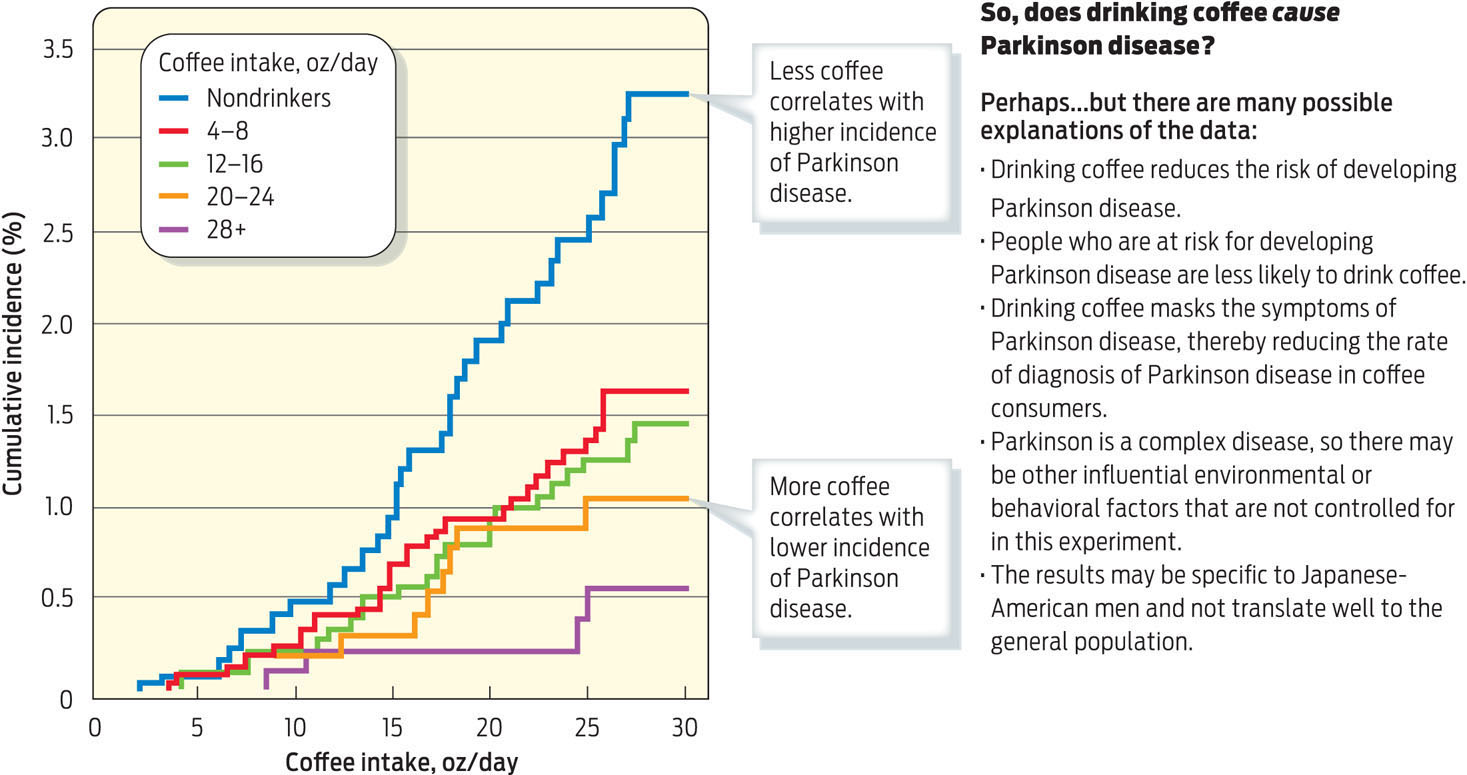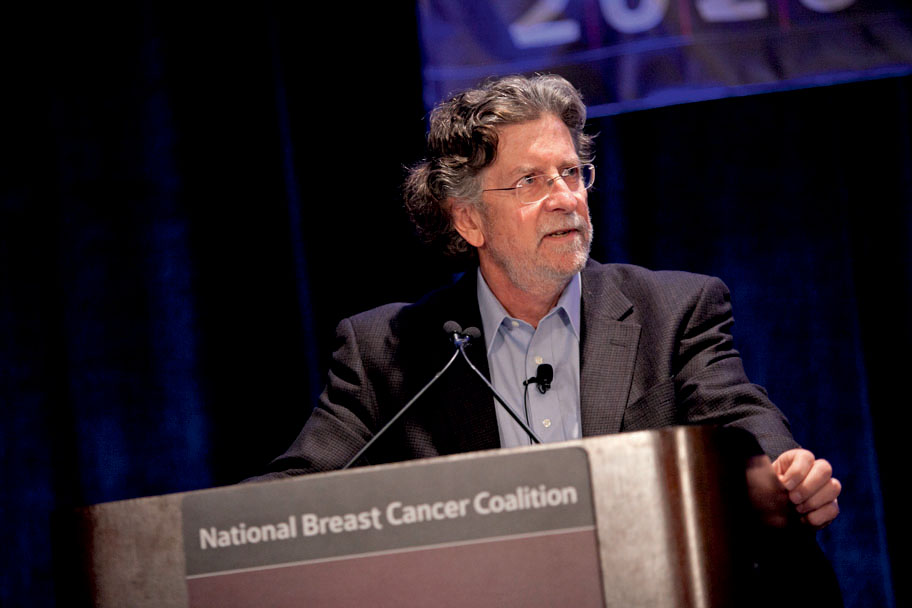FINDING PATTERNS
EPIDEMIOLOGY The study of patterns of disease in populations, including risk factors.
Performing controlled laboratory experiments like those discussed above is one way that scientists try to answer questions. Another approach is to make careful observations or comparisons of phenomena that exist in nature, generating data that can then be analyzed systematically. This is the approach taken by scientists who study epidemiology—the scientific study of the incidence of disease in populations—or a topic like the movement of stars or the nature of prehistoric life, phenomena that cannot be directly experimented upon.

For example, an epidemiologist who wanted to learn about the relationship between cigarette smoking and lung cancer could compare the rates of lung cancer in smokers and nonsmokers. But an experiment in which participants were asked to smoke cigarettes and were observed to see whether or not they developed cancer would be highly unethical.
12
Although epidemiological studies do not provide the immediate gratification of a laboratory experiment, they do have certain advantages. For one thing, they can be relatively inexpensive to conduct, since often the only procedure involved is a participant questionnaire. And you can study factors that are considered harmful, such as excess alcohol or smoking, that you would be unable to test experimentally. Finally, epidemiological studies have the power of numbers and time. The Framingham Heart Study, for example, is a famous epidemiological study that has tracked rates of cardiovascular disease in a group of people and their descendants in Framingham, Massachusetts, in order to identify common risk factors for the disease. Begun in 1948, the study has been going on for decades and has provided mountains of data for researchers in many fields, from cardiology to neuroscience.
Most of the health studies featured in the news are epidemiological studies. Consider a study on coffee and Parkinson disease published in the Journal of the American Medical Association (JAMA) in 2000. Researchers examined the relationship between coffee drinking and the incidence of Parkinson disease, a condition that afflicts more than 1 million people in the United States, affecting men and women of all ethnic groups. There is no known cure, only palliative treatments to help lessen symptoms, which include trembling limbs and difficulty coordinating speech and movement.
For more than 30 years, researchers at the Veterans Affairs Medical Center in Honolulu followed more than 8,000 Japanese-American men, gathering all sorts of information about them: their age, diet, health, smoking habits, and other characteristics. Of these men, 102 developed Parkinson disease. What did these 102 men have in common? Epidemiologists found that most of them did not drink caffeinated beverages—no coffee, soda, or caffeinated tea.
13
 “Consumers are flooded with a firehose of health information every day from various media sources.”
“Consumers are flooded with a firehose of health information every day from various media sources.”
— GARY SCHWITZER
CORRELATION A consistent relationship between two variables.
By contrast, coffee drinkers had a lower incidence of Parkinson disease. In fact, those who drank the most coffee were the least likely to get the disease. Men who drank more than two 12-ounce cups of coffee each day had one-fifth the risk of getting the disease compared to non–coffee drinkers. The same trend was observed for overall caffeine intake that included sources other than coffee.
So does coffee (specifically, caffeine) prevent Parkinson disease? The occurrence and progression of many diseases are affected by a complex range of factors, including age, sex, diet, genetics, and exposure to bacteria and environmental chemicals, as well as lifestyle factors like drinking, smoking, and exercise. Although the study discussed here suggests a link—or correlation—between caffeine and lower incidence of Parkinson disease, it does not necessarily show that caffeine prevents the disease. In other words, correlation is not causation. Perhaps the people who like to drink coffee have different brain chemistry, and it’s this different brain chemistry that explains the differing incidence of Parkinson disease among coffee drinkers (INFOGRAPHIC 1.7)
While the data shown below show a convincing correlation between reduced caffeine intake and an increased risk of Parkinson disease, it is impossible to state that less coffee causes Parkinson disease. Other factors that were not tested or controlled for could be causing the reduced risk.


Indeed, other studies have found that cigarette smoking also correlates with a lower risk of Parkinson disease. Both coffee drinking and smoking could be considered types of thrill-seeking behavior, observed in people who enjoy the high they get from stimulants such as caffeine or nicotine. The lower risk of Parkinson disease among coffee drinkers might therefore result from thrill-seeking brain chemistry that also happens to resist disease—rather than being caused by either smoking or drinking coffee per se.
14
Moreover, the study followed Japanese-American men. Would the same relationship between caffeine and Parkinson disease be seen in other ethnic groups or in women? Several other epidemiological studies have found a correlation between caffeine consumption and a lower incidence of Parkinson disease in men of other ethnicities. But in women the results have been inconclusive. All in all, there’s still no direct evidence that caffeine actually prevents the disease in either men or women.
“While our study found a strong correlation between coffee drinkers and low rates of Parkinson’s disease,” stated the study’s lead author, G. Webster Ross, in a press release, “we have not identified the exact cause of this effect. I’d like to see these findings used as a basis to help other scientists unravel the mechanisms that underlie Parkinson’s onset.”
RANDOMIZED CLINICAL TRIAL A controlled medical experiment in which subjects are randomly chosen to receive either an experimental treatment or a standard treatment (or a placebo).
Finding a correlation that is not necessarily a cause is a typical result of epidemiological studies, but that does not mean such studies are worthless. In fact, as the author of this study of Japanese-American men indicates, correlations can be a jumping-off point for additional research aimed at identifying root causes. Correlations provide suggestive evidence that merits additional research.
To get a clearer picture of caffeine’s role in Parkinson disease, researchers could conduct a type of experiment known as a randomized clinical trial, in which the effects of coffee would be measured directly under controlled conditions. One could divide a population into two groups, put one group on coffee and the other on decaf, and then follow both groups for a number of years to see which one had the higher incidence of disease. The problem with such a study is that it is often logistically challenging to conduct, since it can be difficult to get people to stick to the regimen for the length of the study. (And such studies are unethical if the experimental treatment is likely to cause harm.)
15